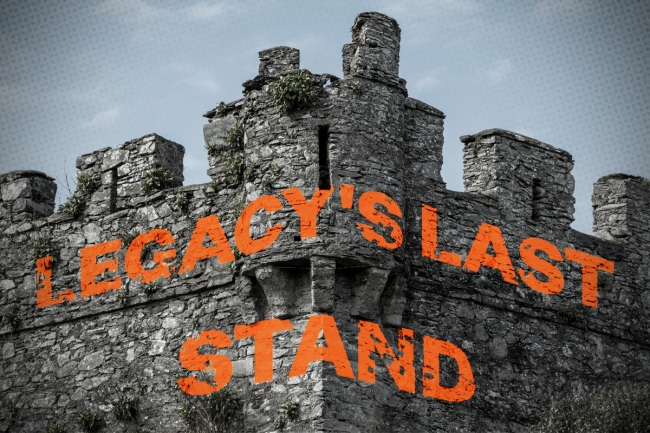You have /5 articles left.
Sign up for a free account or log in.

A bill to ban legacy admissions preferences at public and private colleges has bipartisan support in Connecticut’s legislature.
Legacy preferences have weathered an enormous wave of public disapproval and political attacks since last summer’s Supreme Court decision striking down affirmative action.
Opponents of admissions advantages for descendants of alumni have won a few recent victories; a handful of prominent private institutions eliminated the practice, and recently Virginia outlawed it at public colleges. Now, a critical battle for legacy’s future is playing out in Connecticut’s state legislature, which is currently considering a bill to ban preferences for legacy applicants, as well as relatives of donors, at both public and private colleges.
The bill advanced from the Higher Education and Employment Advancement Committee early this month by an 18-to-4 vote, following a spirited five-hour hearing that featured representatives from seven colleges—who mostly spoke in opposition to the bill—and a number of students and education-equity advocates, all of whom supported it. It now awaits a vote in the state senate, after which it will pass to the general assembly.
Two states have enacted laws banning legacy preferences at public institutions: Virginia and Colorado, which passed its bill in 2021. But Connecticut’s legislation includes private institutions, which tend to guard their autonomy fiercely and give legacy more weight in the admissions process.
The bill initially focused only on alumni legacies but was amended in committee to include a ban on preferences for family members of donors as well, a provision inspired by the Virginia bill. It also includes an exception for institutions that simply want to collect data on applicants’ legacy status without considering it in admissions decisions.
Legislation like Connecticut’s that bans or harshly penalizes legacy preferences began to gain traction after the affirmative action ruling, with similar bills cropping up in Massachusetts, New York and California. While those languish in committee hearings, Connecticut’s has emerged as the likeliest to come to a vote—and to be approved, lawmakers and observers say.
While there’s no penalty outlined in the bill for continuing to consider legacy status—as there is in proposed legislation in Massachusetts and New York—State Senator Derek Slap, who co-sponsored the Connecticut bill, is confident its passage alone would be enough to discourage the practice.
“I think colleges are law-abiding institutions and wouldn’t grant legacy preferences if it’s explicitly against the law,” he said. “If it weren’t a meaningful action, then why are so many institutions fighting so vociferously against it?”
Colleges Come Out Swinging
When Connecticut lawmakers last tried to pass a legacy ban, in 2022, the bill only applied to public institutions—and it was still defeated in the general assembly after a concerted push by the state’s colleges.
Amy Dowell, executive director of the Connecticut chapter of the national advocacy group Education Reform Now, said she’s been fighting for nearly ten years to ban legacy preferences in the state against a united front of resistance that has seemed insurmountable.
This time, she believes there’s almost nothing that can stop its passage.
“The arguments against [the bill] grow thinner by the minute,” she said. “It seems like kind of a last stand for legacy’s defenders.”
That doesn’t mean colleges are any less committed to defending the practice—on the contrary, Dowell said they’re “fighting down to the wire” in a last-ditch effort to stave off government intervention.
Even the University of Connecticut, a public land-grant institution which does not consider legacy in admissions, came out in opposition to the bill, arguing it would undermine institutional autonomy. The only college leader to support the bill was Terrence Chang, chancellor of the Connecticut State Colleges and Universities system.
“To be candid, the biggest obstacle to this bill right now are the deep ties that the colleges have to legislators,” Dowell said.
Institutions are leveraging those relationships, offering a range of justifications for their opposition to the bill: that it would be a slow creep toward greater subjugation of colleges’ autonomy; that legacy admits help them fund equity programs; and that eliminating legacy would make a negligible difference in their institutions’ accessibility.
Fairfield University, for instance, considers legacy preferences in admissions and accepts a high percentage of those candidates: the class of 2026 boasted the institution’s largest legacy population ever, 199 out of 1,340 students—nearly 15 percent. Jennifer Anderson, Fairfield’s vice president of marketing and communications, justified the practice in her testimony to lawmakers by arguing they were attracting and retaining members of the state workforce.
“Over 20,000 alumni live in the state of Connecticut. That’s over half our alumni base who have come to Connecticut and stayed in Connecticut, raising their families in our state,” she said. “The direct and indirect contribution to the state, and town of Fairfield, is significant.”
Jeremiah Quinlan, dean of undergraduate admissions at Yale—where 14 percent of the class of 2025 and 12 percent of the class of 2026 were legacy admits—testified at the committee hearing for over an hour.
“The state should not dictate how colleges and universities make admissions decisions, just as the state should not dictate whom we hire as faculty or what we teach in the curriculum,” he said. “Moreover, [the bill] does not address the real challenge—providing less advantaged Connecticut students with the resources necessary to prepare for college and to graduate on time.”
Officials at Trinity College, where legacy admits make up about 5 percent of the student body, submitted a letter in opposition to the bill as well. They argued that the perception that legacy applicants have a leg up is often based on a fundamental misunderstanding.
“When institutional data shows a ‘preference’ for legacy candidates, that reality is more a byproduct of those candidates’ strong foundation for higher education and the competitive nature of their applications,” they wrote.
Wesleyan University, which eliminated legacy preferences last July, did not testify for or against the bill. President Michael Roth declined to comment to Inside Higher Ed, but the college’s decision hung over discussions of the bill.
“Wesleyan came up quite a lot during the hearing,” Slap said. “It was kind of this watershed moment. If they can do it, why can’t everyone?”
‘The Walls Are Closing In’
Slap isn’t sure if the legacy ban will pass this year; Connecticut’s legislature is in what they call a “short session,” which ends May 8, and passing the legacy bill is not a quick and easy job.
“It will be an uphill battle,” he said. “This is not a bill that will just collect consent. We’re talking hours of floor discussion in each chamber.”
But he said there’s a sense of irreversible momentum to the anti-legacy movement, and even if proponents manage to morph the bill into something more tame—like a version of California’s 2020 bill requiring colleges to release legacy demographic data—he believes the public relations battle is already won.
“The walls are closing in on legacy as public consensus builds against it,” he said. “It’s going to become more and more unpleasant for these institutions to defend this practice.”
It doesn’t help colleges’ cause that Connecticut is both one of the richest and one of the most economically unequal states, and many of its private colleges reflect that. Fairfield has the lowest proportion of PELL recipients of any U.S. postsecondary institution, according to federal data: 7.5 percent of the student body. Trinity College and Sacred Heart University, both of which are also lobbying against the bill, don’t fare much better, with PELL recipients making up 15 percent of their student populations.
Even the Connecticut Council of Independent Colleges—historically a staunch defender of legacy preferences—is equivocating on its position, objecting more to the bill’s details than its spirit.
“While CCIC supports the intent of this bill—to promote equity and access in post-secondary education—we oppose the manner in which the bill seeks to accomplish that goal by interfering with institutional autonomy,” Jennifer Widness, CCIC president, wrote in a brief submitted to lawmakers.
Widness argued that the legislature should instead consider investing in state financial aid for Connecticut students attending private in-state colleges, which she said has been cut by 200 percent since 2012.
Slap said he had no issue calling for more state grants and financial aid funding. But he isn’t convinced that independent colleges are the best stewards of that money, and would prefer it not come from what he sees as unethical sources.
“It’s like a carbon offset tax or something: ‘This is bad, but if you let us do it we can fund good things, too,’” he said. “We don’t want to give the money to these colleges so they can allocate it inequitably, either.”
Dowell said that while private colleges are by no means resigned to the defeat of legacy in Connecticut, there is a sense of inevitability around the bill that makes their arguments ring increasingly hollow among policymakers who were more likely to be swayed in 2022, when the general assembly voted down a similar bill.
“Two years ago, the whole debate felt much more contentious,” Dowell said. “Now it’s much harder to defend, and you can sense that in the way lawmakers are talking about it.”





